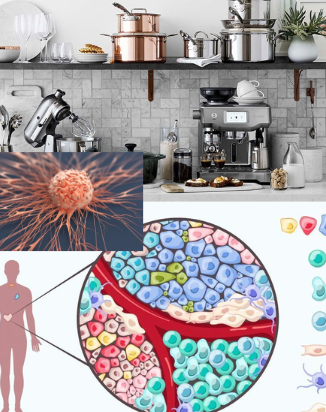
For years, diet, lifestyle, and genetics were considered the primary drivers of most cancers. But a sweeping scientific review of more than 3,000 studies is challenging that belief — pointing the finger at an invisible yet omnipresent culprit: microplastics. These tiny fragments, smaller than 5 millimeters, are now suspected to play a role in colon cancer, lung cancer, infertility, and other serious health conditions. And their reach extends far beyond polluted oceans — they’re in the air we breathe, the food we eat, and even in our bodies.
What Exactly Are Microplastics and Where Do They Come From?
Microplastics are the byproduct of a plastic-dependent world. They shed from everyday products like food packaging, synthetic clothing, children’s toys, cigarette filters, and even car tires. Over time, these fragments break down further, making them almost impossible to detect with the naked eye. Once released, they spread through the environment — contaminating air, water, and soil. And here’s the unsettling truth: they have been found in human placentas, breastmilk, and even brain tissue.
The Surprising Rise of Colon and Non-Smoking Lung Cancers
One of the most disturbing findings from the review is the rise in colon cancer cases among young adults — a demographic historically considered low-risk. Unlike other cancers that are declining, colon and non-tobacco-related lung cancers are climbing, and researchers believe microplastic exposure could be part of the explanation.
These particles can damage the colon’s protective mucus layer, disrupt the immune system, and create chronic inflammation — all conditions that can pave the way for cancer development. Similarly, in the lungs, inhaled microplastics may cause persistent inflammation and tissue damage, raising the risk of lung cancer even in people who have never smoked.
How Microplastics Harm the Body on a Cellular Level
Once microplastics enter the body, the immune system sees them as foreign invaders, triggering inflammation. Over time, this can lead to tissue damage, organ stress, and permanent harm. The review also revealed how microplastics accumulate in critical systems:
- Digestive system: Linked to colon cancer, intestinal cell death, and disruption of gut immunity.
- Respiratory system: Causes chronic lung inflammation, scarring, and increased lung cancer risk.
- Reproductive system: Disrupts hormones, lowers sperm quality, and damages ovarian and placental health.
The researchers didn’t mince words — exposure to microplastics is “suspected” to be a serious hazard to human health, especially in these three systems.
Video : How microplastics affect your health
A $289 Billion Problem for the U.S. Healthcare System
The human cost of microplastic-related diseases is staggering, but the financial cost is also eye-opening. The review estimated that the burden of treating conditions linked to microplastic exposure costs the U.S. healthcare system around $289 billion annually. That’s before factoring in the economic toll of lost productivity and reduced quality of life.
Microplastics and Reproductive Health: A Silent Threat
For men, microplastic exposure has been associated with reduced sperm count, lower sperm motility, and poor testicular health. For women, these particles may impair ovarian function, disrupt hormone balance, and even affect fetal development. Some studies found microplastics in the placenta linked to low birth weight, while others detected them in amniotic fluid tied to premature birth.
This growing body of evidence suggests that reproductive health could be one of the most vulnerable targets of microplastic exposure — with long-term implications for fertility rates.
Why We’re Only Beginning to Understand the Scope of the Problem
The review, published in Environmental Science & Technology, is the first to apply National Academy of Sciences–approved gold-standard methods to comprehensively examine the health effects of microplastics. While most studies so far have been done on animals, the researchers emphasize that humans are exposed to the same environmental pollutants — making the findings highly relevant.
Even more alarming? Plastic production is projected to triple by 2060, meaning microplastic exposure is likely to worsen unless urgent action is taken.
What Can Be Done to Reduce Exposure?
While microplastics are almost impossible to avoid completely, experts recommend several steps to lower personal risk:
- Minimize the use of single-use plastics and opt for glass or stainless steel containers.
- Avoid heating food in plastic, which can release more particles.
- Choose natural fabrics over synthetics like polyester.
- Improve indoor air quality with regular ventilation and HEPA filtration.
- Support policies aimed at reducing plastic production and pollution.
Scientists Call for Immediate Policy Action
Researchers, including senior author Tracey J. Woodruff from UCSF, are urging governments to act. “We know this type of air pollution is harmful, and these microplastics are basically particulate matter air pollution,” she explains. Nicholas Chartres, PhD, lead author and current University of Sydney researcher, adds: “We hope state leaders will take immediate action to prevent further exposures.”
Video : Microplastics and their impact on the human body
Conclusion: An Invisible Crisis with Visible Consequences
Microplastics are no longer just an environmental problem — they are a direct human health crisis. The evidence is stacking up, linking them to cancers, reproductive harm, and chronic diseases. With production on the rise, inaction isn’t an option. Reducing microplastic exposure requires both individual choices and systemic change. The sooner we address this invisible threat, the better our chances of protecting public health for generations to come.


